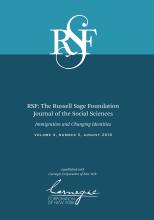Research Article
Open Access
Majority No More? The Influence of Neighborhood Racial Diversity and Salient National Population Changes on Whites’ Perceptions of Racial Discrimination
Maureen A. Craig, Jennifer A. Richeson
RSF: The Russell Sage Foundation Journal of the Social Sciences August 2018, 4 (5) 141-157; DOI: https://doi.org/10.7758/RSF.2018.4.5.07
Maureen A. Craig
aAssistant professor of psychology at New York University
Jennifer A. Richeson
bPhilip R. Allen Professor of Psychology and faculty fellow at the Institution for Social and Policy Studies at Yale University

REFERENCES
- ↵
- ↵
- Alba, Richard,
- Rubén G. Rumbaut, and
- Karen Marotz
- ↵Allport, Gordon W. 1954. The Nature of Prejudice. Cambridge, Mass.: Perseus Books.
- ↵Blalock, Hubert M. 1967. Toward a Theory of Minority-Group Relations. New York: John Wiley & Sons.
- ↵
- Blumer, Herbert
- ↵
- Branscombe, Nyla R.,
- Michael T. Schmitt, and
- Richard D. Harvey
- ↵
- Craig, Maureen A., and
- Jennifer A. Richeson
- ↵
- ↵
- Craig, Maureen A., and
- Jennifer A. Richeson
- ↵
- Craig, Maureen A.,
- Julian M. Rucker, and
- Jennifer A. Richeson
- Craig, Maureen A.,
- Julian M. Rucker, and
- Jennifer A. Richeson
- ↵
- Croll, Paul R.
- ↵Crosby, Faye J. 1982. Relative Deprivation and Working Women. New York: Oxford University Press.
- ↵
- ↵
- ↵Emerson, Michael O., Jenifer Bratter, Junia Howell, P. Wilner Jeanty, and Mike Cline. 2012. “Houston Region Grows More Racially/Ethnically Diverse, with Small Declines in Segregation.” A Joint Report Analyzing Census Data from 1990, 2000, and 2010. Houston, Tex.: Kinder Institute of Urban Research and the Hobby Center for the Study of Texas.
- ↵
- ↵
- Fossett, Mark A., and
- K. Jill Kiecolt
- ↵
- Giles, Michael W., and
- Kaenan Hertz
- ↵
- Goren, Matt J., and
- Victoria C. Plaut
- Hayes, Andrew F. 2013. Introduction to Mediation, Moderation, and Conditional Process Analysis: A Regression-Based Approach. New York: Guilford Press.
- ↵Hing, Bill O. 2004. Defining America Through Immigration Policy. Philadelphia, Pa.: Temple University Press.
- ↵Horowitz, Evan. 2016. “When Will Minorities Be the Majority?” Boston Globe, February 26. Accessed May 28, 2017. https://www.bostonglobe.com/news/politics/2016/02/26/when-will-minorities-majority/9v5m1Jj8hdGcXvpXtbQT5I/story.html.
- ↵Jackson, James S., Vincent Hutchings, Cara Wong, and Ron Brown. 2008. National Politics Study, 2008. ICPSR36167. Ann Arbor, Mich.: Inter-University Consortium for Political and Social Research.
- ↵
- ↵Klineberg, Stephen L. 2010. “The Kinder Houston Area Survey.” Houston, Tex.: Kinder Institute for Urban Research. Accessed January 29, 2018. http://has.rice.edu.
- ↵
- Knowles, Eric D., and
- Kaiping Peng
- ↵Lee, Barrett A., John Iceland, and Gregory Sharp. 2012. “Racial and Ethnic Diversity Goes Local: Charting Change in American Communities Over Three Decades.” New York: Russell Sage Foundation. Accessed May 28, 2017. https://www.russellsage.org/research/reports/racial-ethnic-diversity.
- ↵
- ↵
- Nadeau, Richard,
- Richard G. Niemi, and
- Jeffrey Levine
- ↵
- ↵
- Outten, H. Robert,
- Michael T. Schmitt,
- Daniel A. Miller, and
- Amber L. Garcia
- ↵
- Pettigrew, Thomas F
- ↵
- Pettigrew, Thomas F., and
- Linda R. Tropp
- ↵Pew Research Center. 2015. Modern Immigration Wave Brings 59 Million to U.S., Driving Population Growth and Change Through 2065: Views of Immigration’s Impact on U.S. Society Mixed. Washington, D.C.: Pew Research Center. Accessed January 29, 2018. http://www.pewhispanic.org/2015/09/28/modern-immigration-wave-brings-59-million-to-u-s-driving-population-growth-and-change-through-2065/.
- ↵
- Quillian, Lincoln
- ↵Schildkraut, Deborah S., and Satia A. Marotta. 2017. “Assessing the Political Distinctiveness of White Millennials: How Race and Generation Shape Racial and Political Attitudes in a Changing America.” Paper presented to the Russell Sage Foundation, New York (September).
- ↵
- Schlueter, Elmar, and
- Peer Scheepers
- ↵
- Skinner, Allison L., and
- Jacob E. Cheadle
- ↵
- Taylor, Donald M.,
- Stephen C. Wright,
- Fathali M. Moghaddam, and
- Richard N. Lalonde
- Taylor, Donald M., Stephen C. Wright, and Lana E. Porter. 1994. “Dimensions of Perceived Discrimination: The Personal/Group Discrimination Discrepancy.” In The Psychology of Prejudice: The Ontario Symposium, edited by Mark P. Zanna and James M. Olson. Hillsdale, N.J.: Lawrence Erlbaum.
- ↵U.S. Census Bureau. 2000. “Profile of General Demographic Characteristics: 2000.” Accessed January 29, 2018. https://www.census.gov/prod/cen2000/dp1/2kh00.pdf.
- U.S. Census Bureau. 2013. “Geographic Areas Reference Manual.” Accessed January 29, 2018. https://www.census.gov/geo/reference/garm.html.
- ↵U.S. Census Bureau. 2015. “New Census Bureau Report Analyzes U.S. Population Projections.” Press Release. Washington: Government Printing Office. Accessed January 29, 2018. https://www.census.gov/newsroom/press-releases/2015/cb15-tps16.html.
- ↵Wazwaz, Noor. 2015. “It’s Official: The U.S. Is Becoming a Minority-Majority Nation.” U.S. News & World Report, July 6. Accessed January 29, 2018. http://www.usnews.com/news/articles/2015/07/06/its-official-the-us-is-becoming-a-minority-majority-nation.
- ↵
- ↵Willer, Robb, Matthew Feinberg, and Rachel Wetts. 2016. “Threats to Racial Status Promote Tea Party Support Among White Americans.” SSRN working paper. Stanford, Calif.: Stanford University Graduate School of Business. Accessed May 28, 2017. http://papers.ssrn.com/sol3/papers.cfm?abstract_id=2770186.
- Zou, Linda X., and
- Sapna Cheryan
In this issue
Majority No More? The Influence of Neighborhood Racial Diversity and Salient National Population Changes on Whites’ Perceptions of Racial Discrimination
Maureen A. Craig, Jennifer A. Richeson
RSF: The Russell Sage Foundation Journal of the Social Sciences Aug 2018, 4 (5) 141-157; DOI: 10.7758/RSF.2018.4.5.07
Majority No More? The Influence of Neighborhood Racial Diversity and Salient National Population Changes on Whites’ Perceptions of Racial Discrimination
Maureen A. Craig, Jennifer A. Richeson
RSF: The Russell Sage Foundation Journal of the Social Sciences Aug 2018, 4 (5) 141-157; DOI: 10.7758/RSF.2018.4.5.07
Jump to section
Related Articles
- No related articles found.
Cited By...
- No citing articles found.





